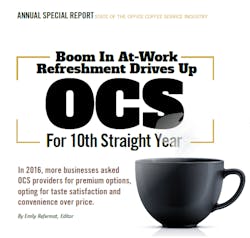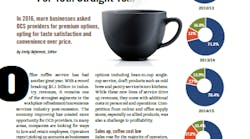Boom In At-Work Refreshment Drives Up OCS Revenue For 10th Straight Year
To review the charts, download the report as a PDF.
Office coffee service has had another great year. With a record breaking $5.1 billion in industry revenues, it remains one of the strongest segments in the workplace refreshment/convenience services industry post-recession. The economy improving has created more opportunity for OCS providers. In many areas, companies are looking for ways to lure and retain employees. Operators report picking up accounts as businesses expand, requesting more robust OCS service. Top among them are premium options including bean-to-cup single-cup service, draft products such as cold brew and pantry service/micro kitchens. While these new lines of service drive up revenues, they come with additional costs in personnel and operations. Competition from online and office supply stores, especially on allied products, was also a challenge to profitability. options including bean-to-cup single-cup service, draft products such as cold brew and pantry service/micro kitchens. While these new lines of service drive up revenues, they come with additional costs in personnel and operations. Competition from online and office supply stores, especially on allied products, was also a challenge to profitability.
Sales up, coffee cost low
Sales rose for the majority of operators, 68.4 percent, although the number did slip from previous years (chart 2). Twice as many OCS providers experienced no increase or decrease in sales over the last 12 months, 22.9 percent compared to 10.4 from the year before. Product and service costs have also increased, although the price of coffee isn’t a main concern.
The average coffee price remains fairly low due to a positive outlook for coffee growing countries. The International Coffee Organization puts the price in August 2017 at 128.24 cents per pound (chart 3). This is lower than the first half of 2016/17 and the second half of 2015. Instead what drove up prices was overhead and competition.
Wages, employee benefit industry
In 2016/17, a greater number of operators reported increases in the common costs of doing business, including taxes, insurance costs, payroll and overhead. The last few years have seen higher minimum wages and overtime mandates for route drivers and other industry employees. However, what is hurting profitability internally is also driving it externally. In the latest U.S. Census Bureau Income and Poverty in the United States: 2016 report, employers across the U.S. were found to have increased the wages paid to employees by an average of 3.2 percent, the second consecutive year there has been an increase. This has a direct impact on the requests for OCS and workplace refreshment services. The companies paying higher wages are operating profitably, and therefore willing to pay for OCS services that act as employee benefits.
More evidence of the improved economy is the unemployment rate being quite low, 4.4 percent, according to the Bureau of Labor Statistics. The rate has almost continuously decreased since August 2015. This can be seen within the industry as well. More operators added staff in 2016/17, 46 percent, higher than the previous year with most of those additions being drivers and delivery staff (chart 11). There were also fewer staff reductions than in the previous year.
Competition challenges
While OCS is a healthy growth segment it is also saturated. OCS providers report increased competition from online retailers such as Amazon and office supply companies, including Staples and WB Mason, as well as each other. Price sensitive locations that buy on cost alone make it difficult for OCS providers to win the business from retailers who treat office coffee like a commodity. Operators especially struggle with single-cup prices, as many of the national names are available from these sources, causing the customer to price shop. The customer doesn’t consider the time, attention and level of service, including timely repairs, that an OCS provider includes as part of the service. This is generally unmatched by online and office supply retailers and is one of the major advantages that OCS providers have.
In competition among OCS providers, getting or keeping the business comes down to the quality of service, including unique offerings. Operators report losing accounts to operations that offer micro markets and to larger corporations with the capital to invest in new brewers and expanded SKUs for pantry service. Businesses continue to ask more from OCS providers, leading many to expand into new services in 2016/17 (chart 10). Among the service types written in were kombucha, cold brew, bulk snacks, popcorn, carbonated/flavored water, hospitality and single-cup. Of the more traditional offerings, pantry service, sometimes called a micro kitchen, and water filtration service were the most added. Pantry service in particular is a large part of current revenues.
When asked to assign revenue to different OCS offerings, coffee came in as number one, not surprisingly, accounting for 39.8 percent of sales (chart 5D). However, next on the list was soft drinks/juice and pantry service. While several definitions exist for pantry service, in this report it refers to the OCS provider delivering beverages, food, bulk snacks, etc. to a location. The company pays for the items and then offers them to employees for free in the break area. To keep up with pantry service demands, operators have added hundreds of SKUs to their warehouses, which need additional inventory and logistics oversight as well as dedicated personnel. This has contributed, in part, to the previously mentioned overhead costs. Despite challenges, pantry service is reported to be very lucrative by operators. It is also less expensive than a cafeteria, with many of the same advantages, making pantry service a tempting benefit employers can offer.
Operators reported lower margins on allied products due to competition this year. The customer is also demanding a greater number of options, making proper SKU management to minimize spoilage a concern. Allied products represent 14 to 38 percent of operator revenues depending on the definition (chart 5D). Having to absorb higher costs in this category combined with adding SKUs has impacted profitability.
Revenue per cup decreases
The revenue per cup of both fraction, or frac, pack and single-cup decreased in 2016/17 (chart 4A&B). However, this was the first year a certain size cup was indicated, 6-ounces, which could account for some of the change. The decrease could also be due to the rise in private label. It accounts for 44.4 percent of sales (chart 5A) and was chosen as the top selling OCS product by 37 percent of respondents. (chart 5C)
Single-cup prices are three times those of frac packs. This is a main reason frac packs still account for the majority of OCS service, despite many locations exploring single-cup options. Operators report that frac packs represented 56.2 percent of their sales in 2016. Comparatively, single-cup represented 30.8 percent, which includes both K-cups and alternatives. However, the percentage of placed single-cup brewers has increased. Out of the total number of brewers, single-cup, in some form, now accounts for 19.7 percent, compared to 16.7 percent in 2015. Pourover and automatic are still the dominate brewer types, although there was a change in calculations from previous years. In 2016, the antiquated terminology of plumbed-in was eliminated, since nearly all pourover and automatic brewers are plumbed it. Taking that change into account, glass pot brewers were flat, while thermal brewers actually decreased in 2016/17 from 39.5% to 36.5%, overall.
More single-cup options drive popularity
It’s no secret that consumers love the idea of brewing coffee one cup at a time. Whether it is the novelty, the ability to brew a personal hot beverage choice, create an espresso-based drink conveniently at work or the newest, must-have OCS innovation, single-cup attracts consumers, despite the fact that it costs more per cup. According to OCS providers placing single-cup equipment, Keurig brewers make up the most market share among single-cup brewers (chart 7). This single-cup product is available in nearly every food retail location, making it difficult for OCS providers to protect margins and keep customers from purchasing product elsewhere. That has led many to look for other single-cup brewer and product options that can be placed at locations. In 2016, the percentage of revenue operators attributed to single-cup, non K-cup was 16.6 percent (chart 5B) showing they are choosing from the increased number of alternate options. Pod brewers specifically have experienced a resurgence in terms of market share (chart 7) with more being placed. Another popular single-cup brewer that boomed in 2016 was bean-to-cup.
Bean-to-cup booms
Bean-to-cup brewers are defined as those that hold whole beans in a hopper attached to the brewer. When a user orders a drink, the appropriate amount of beans is dropped into the grinder, and ground before being brewed to the user’s specification. The process is marketed as producing the sights and smells of the coffeeshop. There is no barista needed, and many brewers have interactive touch screens that let users create gourmet specialty drinks and espressos. The touch screens are reported to be especially popular, and since the cost of service for the bean-to-cup is often less expensive than cartridge/pod-type single-cup brewers, customers consider it better quality and a strong value.
While operators find success with bean-to-cup, most consider their relationship with the customer before placing this type of brewer. Someone on-site has to be designated to refill the hopper with whole beans and clean the equipment on a regular basis, more often than the OCS provider is servicing the account. Also, there is added maintenance compared to traditional OCS brewers due to the grinding and solubles, milk and flavorings, that allow for the specialty drinks. Despite these challenges, it is still being dubbed the fastest growing segment by many operators. Over a third, 38.6 percent, named it the type of single-cup brewer that increased the most in their area.
The popularity of local roasters, those regional coffee shops that have built up a reputation for quality coffee, has played a part in the popularity of bean-to-cup. Operators report that more customers are looking and willing to pay for these trendy, third wave coffee roasts. These roasters rarely have single-cup cartridge or pod options, or even frac packs. They do however sell whole beans, which fits nicely with bean-to-cup brewers.
Location size shrinks
OCS providers report a great number of changes to their location makeup. A majority, 62.2 percent report serving more locations in 2016/17, than in the year before. New business and the strength of the economy were the most reported reasons for the increase. They are also adding locations with fewer employees, illustrated in chart 8. Locations serving 11 to 29 people all jumped in percentage of revenue, while the largest locations, those with 75 or more, decreased.
The types of locations that makeup the OCS landscape changed in 2016/17 as well, with an increase in the number of office and industrial plants contracting OCS services. Convenience stores and schools saw a bit of decline, while retail significantly decreased. Competition was the reason most often given for declines in locations, with some noting business closings.
One topic mentioned by operators, but not shown in the charts was profitability gained by restructuring. A number of OCS providers reported eliminating their least profitable accounts. OCS providers can afford to be a bit more selective of their customers thanks to a strong economy and a transition back to providing workplace refreshment.
Coffee has long been an employee benefit at work, but now employers are taking it to the next level, spending money to bring in quality coffee, beverages and other refreshment. Due to an increasing number of options, including single-cup brewers, OCS providers are able to create a solution tailored to their customers wants, size and budget, while still keeping good margins.

Emily Refermat
Emily began covering the vending industry in 2006 and became editor of Automatic Merchandiser in 2012. Usually, Emily tries the new salted snack in the vending machine, unless she’s on deadline — then it’s a Snickers.
Emily resigned from Automatic Merchandiser and VendingMarketWatch.com in 2019 to pursue other opportunities.






